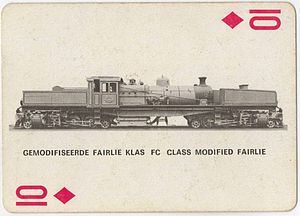SAR class FC
| SAR class FC | |
|---|---|
|
Class FC No. 2310, later redrawn as 670, as a picture on a playing card in the SAR Museum
|
|
| Numbering: | 2310, later 670 |
| Number: | 1 |
| Manufacturer: | North British |
| Year of construction (s): | 1925 |
| Retirement: | 1939 |
| Type : | (1'C1 ') (1'C1') h4 |
| Gauge : | 1067 mm ( cape track ) |
| Length over coupling: | k. A. |
| Service mass: | 101.3 t |
| Friction mass: | 64 t |
| Wheel set mass : | 10.6 t |
| Driving wheel diameter: | 1085 mm |
| Impeller diameter: | k. A. |
| Cylinder diameter: | 355 mm |
| Piston stroke: | 584 mm |
| Boiler overpressure: | 124.1 N / cm² |
| Grate area: | 3.16 m² |
| Radiant heating surface: | 14.4 m² |
| Tubular heating surface: | 114.4 m² |
| Superheater area : | 26 m² |
| Train brake: | Suction air brake |
The one-off class FC of the South African Railways (SAR) was the first of a total of only 16 articulated locomotives of the Modified Fairlie type . The locomotive was intended for a light superstructure with an axle load of around 10.6 t; their axis order was (1'C1 ') (1'C1').
history
Because Beyer-Peacock had protected the Garratt type successfully introduced by SAR with patents, other manufacturers feared they would be forced out of the South African market. The North British Locomotive Works (NBL) therefore developed the "Modified Fairlie" design, which looked like a Garratt but did not infringe the patents. Col Collins, SAR's chief mechanical engineer, showed interest and got involved in the experiment. However, he demanded that the locomotive should correspond as closely as possible to the Garratt class GC, which was developed in parallel .
The FC and GC classes therefore matched in all essential dimensions, and even most of the engine parts were interchangeable. Except for slight deviations in the construction of the boiler, the differences between the two classes were limited to those caused by the joint system, so that a direct comparison of the two types was possible. The classes FD and GD as well as HF and GE formed such pairs - but the latter only with restrictions, since HF and GE differed significantly in the dimensions of their boilers.
A disadvantage of the Modified Fairlie compared to the Garratt turned out to be the large overhangs, which led to greater stress on the pivot pins and thus to higher maintenance costs. It was therefore left with a total of 16 Modified Fairlies in the FC, FC and HF classes, the last of which had already been retired in the 1950s. The FC was already scrapped in 1939, while the GC-Garratts were still in operation until 1964.
literature
- AE Durrant: Garratt locomotives of the world. Birkhäuser, Basel et al. 1984, ISBN 3-7643-1481-8 .
Web links
- The Modified Fairlies of SAR (English)
